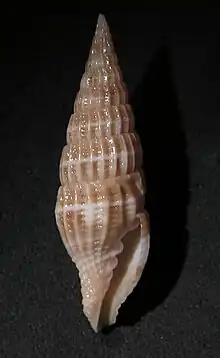| Vexillum sculptile | |
|---|---|
 | |
| Shell of Vexillum sculptile | |
| Scientific classification | |
| Domain: | Eukaryota |
| Kingdom: | Animalia |
| Phylum: | Mollusca |
| Class: | Gastropoda |
| Subclass: | Caenogastropoda |
| Order: | Neogastropoda |
| Superfamily: | Turbinelloidea |
| Family: | Costellariidae |
| Genus: | Vexillum |
| Species: | V. sculptile |
| Binomial name | |
| Vexillum sculptile (Reeve, 1845) | |
| Synonyms[1] | |
| |
Vexillum sculptile, common name the carved mitre, is a species of small sea snail, marine gastropod mollusk in the family Costellariidae, the ribbed miters.[1]
Description
The length of the shell attains 17 mm.
(Original description) The elongated shell is somewhat cylindrical and a little recurved at the base. The sutures of the spire are rather impressed. The shell is longitudinally closely ridged with beautiful shining riblets. The interstices transversely strongly latticed. The decussating cancellations are so regularly disposed, with the white stramineous and fuscous zoned spiral bands that they can serve to characterize the species. The shell is whitish, faintly spotted with pale brown. The lower portion of the body whorl is pale brown, whitish at the base. The columella is five-plaited. [2] [3]
Distribution
This species occurs in the Persian Gulf; also off the Philippines, Indonesia and the Maldives; in the East China Sea; off the Fiji Islands, New Caledonia and Australia (Queensland).
References
- 1 2 Vexillum sculptile (Reeve, 1845). Retrieved through: World Register of Marine Species on 24 April 2010.
- ↑ Reeve, L. A. (1844-1845). Monograph of the genus Mitra. In: Conchologia Iconica, or, illustrations of the shells of molluscous animals, vol. 2, pl. 1-39 and unpaginated text. L. Reeve & Co., London.
 This article incorporates text from this source, which is in the public domain.
This article incorporates text from this source, which is in the public domain. - ↑ Melvill, J. C. (1918). Descriptions of thirty-four species of marine Mollusca from the Persian Gulf, Gulf of Oman and Arabian Sea, collected by Mr. F. W. Townsend. Annals and Magazine of Natural History. ser. 9, 1: 137-158, pls 4-5
 This article incorporates text from this source, which is in the public domain.
This article incorporates text from this source, which is in the public domain.
- Smith, E.A. 1876. A list of marine shells, chiefly from the Solomon Islands, with descriptions of several new species. Journal of the Linnean Society of London, Zoology 12: 535–562, pl. 30
- Smith, E.A. 1903. Marine Mollusca. (pp. 589-630, pls. XXXV-XXXVI) in Gardiner, J.S. (ed.). The Fauna and Geography of the Maldive and Laccadive Archipelagoes, being the account of work carried on and of the collections made by an expedition during the years 1899 and 1900. Cambridge : University Press Vol. II(Part II) pp. 589–698, pls. XXXV-XLVIII).
- Hedley, C. 1908. Studies on Australian Mollusca. Part 10. Proceedings of the Linnean Society of New South Wales 33: 456–489
- Schepman, M.M. 1911. The Prosobranchia of the Siboga Expedition. Part 4: Rhachiglossa. pp. 247-364, pls 18-24 in Weber, M. (ed.). Siboga Expeditie. Monograph 49.
- Ray, H.C. 1954. Mitres of Indian waters (Mollusca, Gastropoda, Family Mitiridae). Memoirs of the Indian Museum 14(1): 1-72
- Cernohorsky, W.O. 1970. Systematics of the families Mitridae & Volutomitridae (Mollusca: Gastropoda). Bulletin of the Auckland Institute and Museum. Auckland, New Zealand 8: 1-190
- Cernohorsky, W.O. 1978. Tropical Pacific marine shells. Sydney : Pacific Publications 352 pp., 68 pls.
- Salisbury, R.A. 1999. Costellariidae of the World, Pt. 1. Of Sea and Shore 22(3): 124-136
- Wilson, B. 1994. Australian marine shells. Prosobranch gastropods. Kallaroo, WA : Odyssey Publishing Vol. 2 370 pp.
- Guillot de Suduiraut, E. 2000. Contribution à la connaissance de quelques gastéropides mitriformes e l'archipel des Philippines (Gastropoda: Prosobranchia: Mitridae & Costellariidae). Xenophora. Association française de conchyliologie 89: 8-12